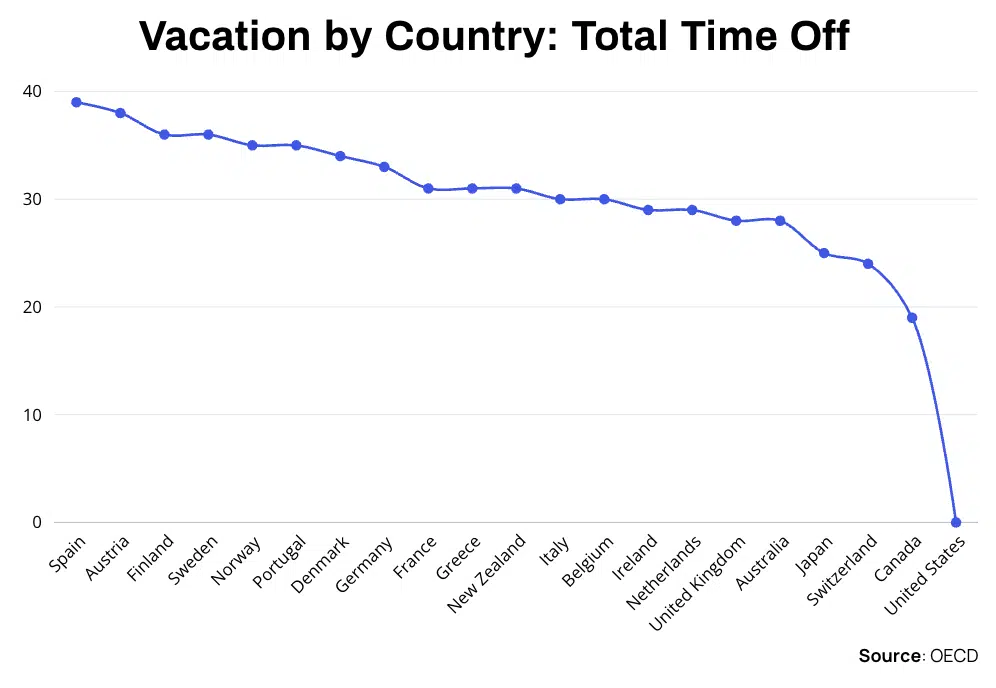
Summer Is Here and Vacation Is Calling: How to Promote Good PTO Hygiene
In workplaces across the country, as summer gets into full swing, thoughts turn to taking a break from the daily grind for some well-deserved rest and relaxation. The time-honored tradition of summer vacation holds benefits for employees and employers alike, as well-rested workers are often happier and more productive, less prone to burnout, and more satisfied with their jobs.
Although there are variations, employers generally package the paid time off (PTO) they grant their employees in two main ways, either dividing that time into a prescribed number of days for sick (or caregiving) leave and a prescribed number of days for vacation leave—or giving workers a “lump sum” of PTO days to use as they see fit.
Although U.S. employers grant a relatively anemic amount of PTO to their employees compared to companies in other industrialized countries (see below), American workers leave a stunning amount of that time on the table. A 2023 Pew Research Center survey found that 46% of U.S. workers take less PTO than they are offered.
The employees surveyed by Pew gave a number of reasons for this, although nearly half (49%) said it’s because they fear falling behind at work. Forty-three percent said they feel guilty about their coworkers picking up the slack when they are away.
Pew found that managers were even more likely to not take the PTO they are entitled to (54%), indicating that it may ultimately be a company’s work culture—rather than the amount of PTO it offers—that determines whether its employees are overworked and burned out or regularly refreshed with opportunities to recharge.
The Big Picture
Of the 38 member countries of the Organisation for Economic Cooperation and Development (OECD), the U.S. is the only one that does not require employers by law to provide their workers paid time off. European countries provide a minimum of 20 required days of paid leave annually, with Spain providing the most at 39 days. Japan gives its workers 25 days off, and Canada provides 19.
While nearly one-third (31%) of U.S. workers (which translates to 28 million Americans) receive no PTO at all from their employers, the average American gets 11 paid vacation days per year. That number increases with tenure, with employees earning an average of 15 vacation days after five years, and 17 vacation days after 10 years.
In the U.S., “work/life balance” is often invoked by many organizations as one of their prime selling points to prospective employees. But that doesn’t always translate into prioritizing PTO. In a 2024 Forbes Advisor survey on employee benefits, mandatory time off did not make the top five benefits that employers think their workers want. Employees ranked required PTO higher, including it in the top five benefits they value from employers—along with healthcare, retirement plans, mental health assistance, and life insurance.
PTO Hygiene
Regardless of the type and amount of PTO your company provides, it’s the responsibility of HR to promote good PTO hygiene. That means promoting a healthy work/life balance by ensuring—at least within the parameters of your company’s benefits—that employees take the time off to which they are entitled. There are a number of ways to do this:
1. Tell managers to set an example.
To help employees take advantage of restorative time off when they need it, encourage managers to be sensitive to when their direct reports may be neglecting their well-being by not taking adequate PTO. Better yet, urge managers to demonstrate that it’s okay to take necessary down time by taking adequate vacation days themselves. Employees with supervisors who either take minimal time off or continue to work while “on vacation” are more likely to think the same thing is expected of them.
2. Encourage vacationing employees to leave work at the office and disconnect electronically.
Just because an employee is not in the office doesn’t mean they aren’t working. More than half (52%) of employees report working while on PTO by checking messages, joining conference calls, or catching up on projects. Urge vacationing employees to truly disconnect from their work. This may take the form of reminding them how to use the out-of-office function on their email or record temporary voicemail messages. If, as a function of their job, an employee absolutely cannot completely disconnect while on PTO, encourage them to minimize their work communications and set expectations ahead of time that their responses may be delayed.
3. Urge employees to back one another up.
Many employees are better able to relax if they know someone they trust is minding the store while they are away. Encourage employees to ask colleagues if they can designate them as an alternative contact in their automated out-of-office email messages or voicemails, and urge them to return the favor when their coworkers take their vacation time.
4. Track employee time off.
Use your payroll function to track employee time off and set alerts if someone is overdue for vacation or runs up against a “use it or lose it” rule. Remind those employees of the PTO to which they are entitled and encourage them to use it.
The Myth of “Unlimited PTO”
While the number of organizations that offer unlimited PTO is small (only 6%, according to one survey), it has spread to some large companies (including Goldman Sachs, Netflix, General Electric, and Zoom) and is generally viewed as an effective recruiting tool. But, as with many things that appear to be too good to be true, the devil can be in the details.
Some employees of companies with an unlimited PTO policy cite a lack of clarity regarding when it is actually permissible to take time off. They may be hyper-vigilant of how much time their peers are taking off, continually comparing themselves to the company’s highest achievers. Or they may wait for cues from their supervisors—whom themselves may take little vacation time.
The end result can be that employees in companies with an open leave policy actually take less time off than those who work for companies with a prescribed amount of PTO. According to Forbes, the average American takes 17 PTO days a year, while workers with unlimited PTO take 10 days off. HR services firm Namely found that employees of companies with both unlimited PTO and those with a prescribed number of PTO days take about the same amount of time off.
Culture Is King
Regardless of the amount of PTO a company provides, its culture may be the biggest determinant of whether its employees are well-rested and productive or exhausted and burned out. HR can encourage employees to make the most of the time-off benefits they receive and urge managers and company leadership to provide good examples of what work/life balance looks like in practice. In the end, organizations that ensure their employees are free to recharge guilt-free from well-deserved PTO will be better positioned to succeed in the marketplace.
—
The information contained in this site is provided for informational purposes only, and should not be construed as legal advice on any subject matter.

Advice in Your Inbox
Join our newsletter for free bi-monthly toolkits and downloads on how to hire, support, and retain your best talent.







